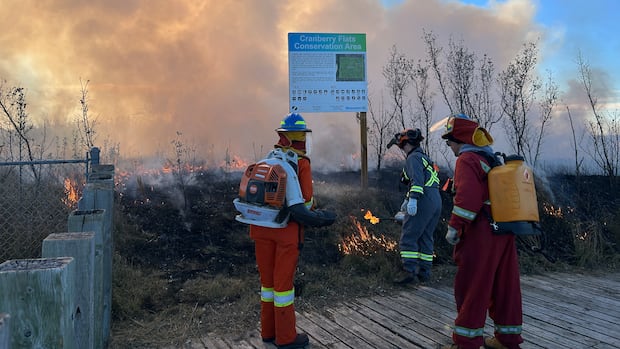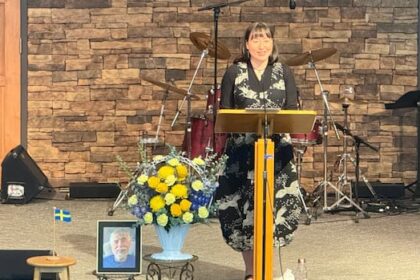SaskatchewanThere was no cloud in the sky when a group of around 20 people wearing hard hats and safety gear gathered at Cranberry Flats to set the conservation area south of Saskatoon on fire. 60 participants from Canada and the U.S. meet in Saskatoon to learn about prescribed firesTheresa Kliem · CBC News · Posted: Oct 28, 2025 9:00 AM EDT | Last Updated: 3 hours agoListen to this articleEstimated 4 minutesParticipants in the Prescribed Fire Training Exchange (TREX) in Saskatoon start a fire with a drip torch at Cranberry Flats Conservation Area on Wednesday, Oct. 22, 2025. (Theresa Kliem/CBC)A group of around 20 people wearing hard hats and safety gear gathered recently under a cloudless sky at Cranberry Flats, to set the conservation area south of Saskatoon on fire.Flames and smoke quickly turned the brown grassland black and the blue sky grey; but instead of destruction, this fire will work like medicine for nature, boosting the health of the prairie environment.The people using drip torches to light the area were part of the Prescribed Fire Training Exchange (TREX) in Saskatoon, a five-day learning event bringing together people from Western Canada and beyond.“We have multiple partners here in Saskatoon that have been burning together for nearly 30 years,” said Renny Grilz, manager of conservation with the Meewasin Valley Authority, one of the agencies organizing the TREX event.“Saskatoon is actually one of the hubs of prescribed fire here in Western Canada.”LISTEN | Saskatoon Morning:Saskatoon Morning8:2960 people meet in Saskatoon to learn about prescribed fires and how to manage themA new group of people is picking up the drip torch, helping Mother Nature get a makeover.Last week, 60 people from Western Canada and beyond learned all about prescribed fires and their benefits. They got together in Saskatoon for a five-day training event, including trainers from the United States.CBC’s Theresa Kliem met with some participants of the Prescribed Fire Training Exchange (TREX) at the Cranberry Flats Conservation Area.”I’ve always been in love with fire,” says trainerLand managers, ranchers and firefighters were among the 60 participants from 27 different agencies.Some came all the way from the United States to share their knowledge with the next generation of people keen to learn how to conduct prescribed fires in a safe manner.“I’ve always been in love with fire,” said lead trainer Melanie Schmidt.“I think the first time I learned about prescribed fire, I was just hooked.”Schmidt works with the Nature Conservancy in the United States and has turned her passion for fire into a career.Melanie Schmidt and other participants of the 2025 Prescribed Fire Training Exchange get ready for a planned burn at the Cranberry Flats Conservation Area on Wednesday, Oct. 22, 2025. The Canadian Prairies Prescribed Fire Exchange organized TREX in collaboration with the Meewasin Valley Authority and other partners. (Theresa Kliem/CBC)The land around Saskatoon looks familiar to her, as it’s similar to the tallgrass prairie in Iowa where she lives. However, there are some differences in the types of grasses, the species of brush and trees, and how they respond to fire.“For centuries, Indigenous folks have been using fire,” Schmidt said.“So we’re just continuing to try to share that message in a positive way, that fire can be a tool. When it’s used appropriately, it can be beneficial and really great for the landscapes, wildlife and the people that call it home.”The benefits of “good fire”At Cranberry Flats, one little critter in particular might benefit from the phoenix treatment, Grilz said.The prescribed burn is expected to enhance the habitat for species at risk, like the Gibson’s Big Sand Tiger Beetle.Loss of habitat is the primary threat to the insect because it burrows in sand and requires shifting dunes, according to the Government of Canada.“What we’re trying to do is open and expose some sand on this site,” Grilz said.“We’re trying to enhance the site for grassland bird habitat as well, mainly species at risk birds … and [we are] also reducing the fire risk on this site as well. This is a public site. We get a lot of people coming out here going for hikes, going down to the river.”Sarah Bradley and Melanie Schmidt get ready for the first prescribed fire at Cranberry Flats Conservation Area since 2018. (Theresa Kliem/CBC)Out-of-control wildfires caused a lot of destruction in Saskatchewan throughout the summer, burning homes, displacing communities and decimating forest habitats.Applying prescribed burns, or “good” fire, on the landscape can help mitigate the effects of these uncontained wildfires, said Sarah Bradley, a stewardship coordinator with the Nature Conservancy of Canada.“I think fire can be scary for people,” said Bradley, who served as division lead during the prescribed burn on Wednesday.“If you don’t understand it, it’s very intimidating. But we also need to recognize that fire is an important ecosystem process.”Park grassland ecologist Dale Gross (left) and division lead Sarah Bradley (right) were two of the people involved in running the prescribed fire at Cranberry Flats on Wednesday, Oct. 22, 2025. (Theresa Kliem/CBC)Meticulous planning for months or years Careful planning plays a major role for people who manage controlled burns. The conditions have to be just right, including temperature, wind, humidity, and topography, Bradley said.“We can have these plans for years … and then it just doesn’t happen.”That wasn’t the case on Wednesday.Despite not quite perfect wind conditions, teams worked together to check equipment and talk through the game plan before starting a test fire and eventually burning 27 acres in the first prescribed fire on the site since October 2018.“You can just feel the energy and the excitement,” Bradley said. “Everybody has been so good about teaching each other what they know and helping each other out. It’s great to be the division lead and to see that in action.”Melanie Schmidt and other TREX participants start a controlled fire at Cranberry Flats to reestablish native vegetation, reduce the encroachment of woody plants, and lower wildfire risk by reducing fuel buildup. (Theresa Kliem/CBC)ABOUT THE AUTHORTheresa Kliem is a journalist with CBC Saskatoon. She is an immigrant to Canada and loves telling stories about people in Saskatchewan. Email theresa.kliem@cbc.ca.
Good burn: Prescribed fire is medicine for Sask. grasslands











